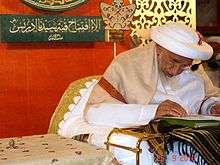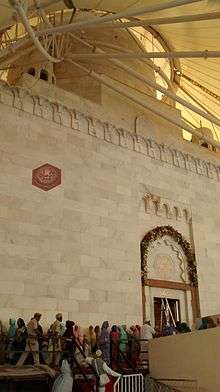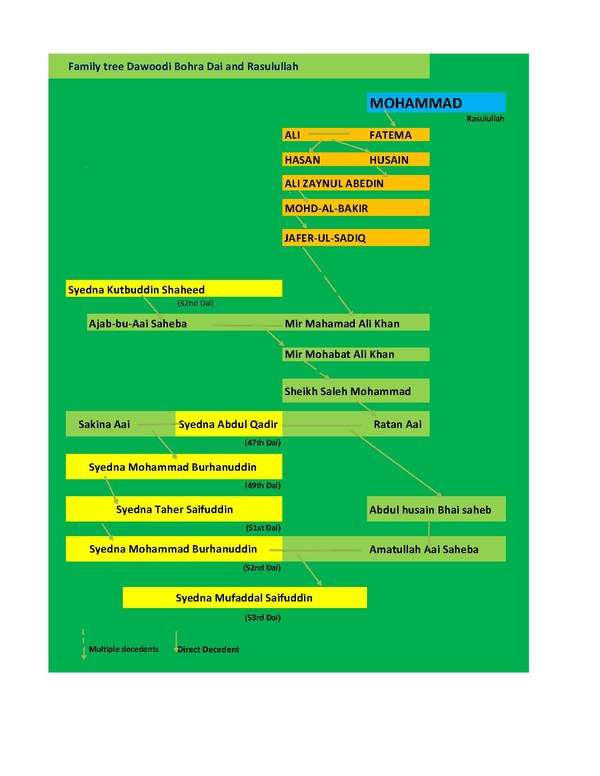Mohammed Burhanuddin
| Mohammed Burhanuddin 52nd Dā'ī al-Mutlaq of the Dawoodi Bohra | |
|---|---|
 delivering sermon during his Yemen visit in 2010 | |
| Born |
6 March 1915 Surat, Gujarat, British Raj |
| Died |
17 January 2014 (aged 98) Malabar Hill, Mumbai, India |
| Cause of death | Cardiac arrest[1] |
| Resting place | Raudat Tahera, Mumbai |
| Style | His Holiness |
| Term | 1965–2014 |
| Predecessor | Syedna Taher Saifuddin |
| Successor | Mufaddal Saifuddin[2][3][3][4] |
| Spouse(s) | Aaisaheba Amatullah |
| Children | Mufaddal Saifuddin, Qaidjoher Ezzuddin |
| Parent(s) |
Taher Saifuddin Aaisaheba Husaina |
| Relatives |
Jafar us Sadiq Imaduddin (grand-son) Husain Saifuddin (grand-son) Taha Saifuddin (grand-son) Khuzaima (half-brother) Taher (half-nephew) |
| Awards | Star of Jordan, Padma Shri, Order of the Nile[1] |
| Signature | |
|
| |

Syedna Mohammed Burhanuddin (6 March 1915 – 17 January 2014)[5] was the 52nd Dā'ī al-Mutlaq of Dawoodi Bohras, a subgroup within the Mustaali, Ismaili Shia branch of Islam.[6] He was appointed as the 52nd Dā'ī al-Mutlaq at the age of 52 in 1967.[7] He was the longest living Dā'ī al-Mutlaq of the Dawoodi Bohra community.[8][9] Compared to those of his predecessor, Burhanuddin's policies were aimed at Islamization of his sect.[10]
Burhanuddin was presented the highest national civic honors by the leaders of Egypt and Jordan.[11] He was the first Dā'ī al-Mutlaq to visit Europe and America.[12]
Early life
Burhanuddin was born to Taher Saifuddin and Aaisaheba Husaina Aaisaheba in Surat in the Indian state of Gujarat.[9][13]:16 He was educated by his father, Taher Saifuddin.[14]
At the age of twelve, he survived a car accident in Colombo, Sri Lanka, where his vehicle got hung on one wheel.[15]
Literary works
Rasāʾil Ramaḍāniyya (Epistles)
The following are a list of Rasāʾil Ramaḍāniyya composed by Mohammed Burhanuddin . Each Risalah is given a title gematrically equivalent to the Hijri year of its publication:[16][17]
| ID | Title | Title (English) | Hijri | Pub. | Year |
|---|---|---|---|---|---|
| SMB 00 | حكمة الغيبة الحقيقية | Hikmat al-Ghaybah al-Haqiqiyyah | 1385H | ||
| SMB 01 | استفتاح زبد المعارف | Isteftah Zubad al-Ma'arif | 1385H | 1386H | |
| SMB 02 | فيوضات الجنة | Fuyoodhaat al-Jannah | 1386H | ||
| SMB 03 | سلام نضرة النعيم | Salaam Nadrah al-Na'eem | 1387H | ||
| SMB 04 | ذات النور | Zaat al-Noor | 1388H | ||
| SMB 05 | ظهور مجد الفاطميين | Zuhoor Majd al-Fatimiyeen | 1389H | ||
| SMB 06 | بركة صبغة الله | Barakah Sibghah Allah | 1390H | ||
| SMB 07 | نشر الخير [18] | Nashr al-Khayr | 1391H | 1437H | 2017 |
| SMB 08 | ندى الفيوضات [19] | Nadā al-Fūyūdāt | 1392H | 1438H | 2018 |
| SMB 09 | سلسبيل روض القدس [20] | Salsabīl Rawd al-Quds | 1392H | 1439H | 2019 |
Activities
Burhanuddin issued a dress code, calling for male Bohras to grow a beard and wear a white topi and kurta, and for females to wear a colorful two piece abaya. This Islamization countered a trend toward assimilation into the larger (Hindu-oriented) culture of their neighbors that was prevalent under his predecessor, Taher Saifuddin.[10]
In October 1999, Burhanuddin was elected Chancellor of the Aligarh Muslim University,[21] a position that his father also held. He is credited with expanding the two century old Arabic university Al Jamea tus Saifiyah. In 1983, a new campus of "Al Jamea tus Saifiyah" was built in Karachi by him.[14][22] He built "Burhaniyah Business Counselling Centre" in Mumbai to provide modern business solutions.[14] He built Raudat Tahera, a mausoleum of his father Taher Saifuddin in Mumbai, India. It is unique for its kind, having the entire Quran inscribed on its inner white walls in letters of gold and with precious stones.[14][23] It was inaugurated in 1975 by the erstwhile President of India Fakhruddin Ali Ahmed.
In 1998, he constructed the Mahad al-Zahra institute for memorization and recitation of the Quran.
Mohammed Burhanuddin is credited with the establishment of community kitchens to provide meals everyday to the Dawoodi Bohra families, thus providing free time for women to pursue economic, educational or religious activities.[24][25] The community kitchens don't discriminate between the privileged and the underprivileged sections, both getting the same "good quality and hygienically-prepared" food,[26] while the community members have the provision of paying for their own family, and for sponsoring those who cannot afford it.[27]
Mohammad Burhanuddin is also credited with conceptualizing and establishing Saifee Hospital in Mumbai. The hospital is a state-of-the-art, multi-specialty, 250-bed hospital dedicated to providing modern medical care.[28] It was inaugurated in 2005 by Dr. Manmohan Singh, the erstwhile prime minister of India.[29]
Ashara Mubaraka
The following are the venues where Mohammed Burhanuddin has performed Ashara Mubaraka:
- 1435AH/2013AD-Mumbai,

- 1431/2009–Marol, Mumbai,



- 1428/2007–Colombo,


- 1425/2004– Dubai, U.A.E.; 1424/2003 – Mumbai;

- 1422/2001– Houston,



- 1419/1998– Nairobi,



- 1416/1995– Mombasa,



- 1413/1992– Pune,



- 1410/1989– Surat,


- 1407/1986– Indore, India; Hijra 1406 / 1985 – Surat, India


- 1404/1983– Karachi;



- 1401/1980- Cairo,


- 1398/1977– Karachi,


- 1395/1975– Mumbai, India; Hijra 1394 / 1974 – Mumbai, India; Hijra 1393 / 1973 – Mumbai,

- 1392/1972– Surat, India; Hijra 1391 / 1971 – Kolkata,


- 1389/1969– Mecca,


- 1386/1966- Mumbai,

Awards and honours
- "Order of the Star of Jordan", the highest civic honour of Jordan by the King of Jordan.[1]
- "Order of the Nile", the highest civilian honour of Egypt.[30]
- "Honorary Doctrates", by Al-Azhar University, Egypt, Aligarh Muslim University, India and University of Karachi, Pakistan.[31]
- On 6 March 2011, Burhani Foundation, India made largest distribution of bird feeders (20,631) to celebrate Mohammed Buranuddin 100th birthday (according to the Islamic calendar). It was recorded in Guinness World Records.[32][33]
- Padma Shri, the fourth highest civilian award of India, in 2015.[34]
- Mohammed Burhanuddin was named one of The 500 Most Influential Muslims in the years 2009, 2010, 2011, 2012 & 2013.[35]
Death
Burhanuddin died of cardiac attack at his home Saifee Mahal in Mumbai on 17 January 2014.[1] The Bohra community announced a 40-day mourning period in respect of the departed leader.[36] He was buried at Raudat Tahera Mausoleum in Bhendi Bazar, Mumbai beside his father Taher Saifuddin.[31] His second son Mufaddal Saifuddin led the "Namaz-e-Janaza" (funeral procession) of his father at the Saifee Mosque.[31] Half mast of Flag and state honor was given by Indian Government during his funeral.[37]
The day after his death, a crowd of supporters assembled outside his residence to pay their respects; when the gates were opened to let them in, a human stampede ensued, killing eighteen people.[38] A commemoration service held one year after Burhanuddin's death drew an estimated three lakh people to Mumbai; two townships were built specially to accommodate them.[39]
Succession
| Family tree Moulai Tarmal/Bharmal to Syedna Burhanuddin | ||||||||||||||||||||||||||||||||||||||||||||||||||||||||||||||||||||||||||||||||||||||||||||||||||||||||||||||||||||||||||||||||||||||||||||||||||||||||||||||||||||||||||||||||||||||||||||||||||||||||||||||||||||||||||||||||||||||||||||||||||||||||||||||||||||||||||||||||||||||||||||||||||||||||||||||||||||||||||||||||||||||||||||||||||||||||||||||||||||||||||||||||||||||||||||||||||||||||||||||||||||||||||||||||||||||||||||||||||||||||||||||||||||||||||||||||||||||||||||||||||||||||||||||||||||||||||||||||||||||||||||||||||||||||||||||||||||||||||||||||||||||||||||||||||||||||||||||||||||||||||||||||||||||||||||||||||||||||||||||||||||||||||||||||||||||||||||||||||||||||||||||||||||||||||||||||||||||||||||
|---|---|---|---|---|---|---|---|---|---|---|---|---|---|---|---|---|---|---|---|---|---|---|---|---|---|---|---|---|---|---|---|---|---|---|---|---|---|---|---|---|---|---|---|---|---|---|---|---|---|---|---|---|---|---|---|---|---|---|---|---|---|---|---|---|---|---|---|---|---|---|---|---|---|---|---|---|---|---|---|---|---|---|---|---|---|---|---|---|---|---|---|---|---|---|---|---|---|---|---|---|---|---|---|---|---|---|---|---|---|---|---|---|---|---|---|---|---|---|---|---|---|---|---|---|---|---|---|---|---|---|---|---|---|---|---|---|---|---|---|---|---|---|---|---|---|---|---|---|---|---|---|---|---|---|---|---|---|---|---|---|---|---|---|---|---|---|---|---|---|---|---|---|---|---|---|---|---|---|---|---|---|---|---|---|---|---|---|---|---|---|---|---|---|---|---|---|---|---|---|---|---|---|---|---|---|---|---|---|---|---|---|---|---|---|---|---|---|---|---|---|---|---|---|---|---|---|---|---|---|---|---|---|---|---|---|---|---|---|---|---|---|---|---|---|---|---|---|---|---|---|---|---|---|---|---|---|---|---|---|---|---|---|---|---|---|---|---|---|---|---|---|---|---|---|---|---|---|---|---|---|---|---|---|---|---|---|---|---|---|---|---|---|---|---|---|---|---|---|---|---|---|---|---|---|---|---|---|---|---|---|---|---|---|---|---|---|---|---|---|---|---|---|---|---|---|---|---|---|---|---|---|---|---|---|---|---|---|---|---|---|---|---|---|---|---|---|---|---|---|---|---|---|---|---|---|---|---|---|---|---|---|---|---|---|---|---|---|---|---|---|---|---|---|---|---|---|---|---|---|---|---|---|---|---|---|---|---|---|---|---|---|---|---|---|---|---|---|---|---|---|---|---|---|---|---|---|---|---|---|---|---|---|---|---|---|---|---|---|---|---|---|---|---|---|---|---|---|---|---|---|---|---|---|---|---|---|---|---|---|---|---|---|---|---|---|---|---|---|---|---|---|---|---|---|---|---|---|---|---|---|---|---|---|---|---|---|---|---|---|---|---|---|---|---|---|---|---|---|---|---|---|---|---|---|---|---|---|---|---|---|---|---|---|---|---|---|---|---|---|---|---|---|---|---|---|---|---|---|---|---|---|---|---|---|---|---|---|---|---|---|---|---|---|---|---|---|---|---|---|---|---|---|---|---|---|---|---|---|---|---|---|---|---|---|---|---|---|---|---|---|---|---|---|---|---|---|---|---|---|---|---|---|---|---|---|---|---|---|---|---|---|---|---|---|---|---|---|---|---|---|---|---|---|---|---|---|---|---|---|---|---|---|---|---|---|---|---|---|---|---|---|---|---|---|---|---|---|---|---|---|---|---|---|---|---|---|---|---|---|---|---|---|---|---|---|---|---|---|---|---|---|---|---|---|---|---|---|---|---|---|---|---|---|---|---|---|---|---|---|---|---|---|---|---|---|---|---|---|---|---|---|---|---|---|---|---|---|---|---|---|---|---|---|---|---|---|---|---|---|---|---|---|---|---|---|---|---|---|---|---|---|---|---|---|---|---|---|---|---|---|---|---|---|---|---|---|---|---|---|---|---|---|---|---|---|---|
|
| ||||||||||||||||||||||||||||||||||||||||||||||||||||||||||||||||||||||||||||||||||||||||||||||||||||||||||||||||||||||||||||||||||||||||||||||||||||||||||||||||||||||||||||||||||||||||||||||||||||||||||||||||||||||||||||||||||||||||||||||||||||||||||||||||||||||||||||||||||||||||||||||||||||||||||||||||||||||||||||||||||||||||||||||||||||||||||||||||||||||||||||||||||||||||||||||||||||||||||||||||||||||||||||||||||||||||||||||||||||||||||||||||||||||||||||||||||||||||||||||||||||||||||||||||||||||||||||||||||||||||||||||||||||||||||||||||||||||||||||||||||||||||||||||||||||||||||||||||||||||||||||||||||||||||||||||||||||||||||||||||||||||||||||||||||||||||||||||||||||||||||||||||||||||||||||||||||||||||||||
| Broken lines indicate multiple generations | ||||||||||||||||||||||||||||||||||||||||||||||||||||||||||||||||||||||||||||||||||||||||||||||||||||||||||||||||||||||||||||||||||||||||||||||||||||||||||||||||||||||||||||||||||||||||||||||||||||||||||||||||||||||||||||||||||||||||||||||||||||||||||||||||||||||||||||||||||||||||||||||||||||||||||||||||||||||||||||||||||||||||||||||||||||||||||||||||||||||||||||||||||||||||||||||||||||||||||||||||||||||||||||||||||||||||||||||||||||||||||||||||||||||||||||||||||||||||||||||||||||||||||||||||||||||||||||||||||||||||||||||||||||||||||||||||||||||||||||||||||||||||||||||||||||||||||||||||||||||||||||||||||||||||||||||||||||||||||||||||||||||||||||||||||||||||||||||||||||||||||||||||||||||||||||||||||||||||||||
Syedna Mohammed Burhanuddin, died in January 2014.[40] As per the tenets of the sect[41] each predecessor is required to nominate his successor prior to his death.[42][43] His death sparked a succession crisis where two rival claimants emerged for the title of 53rd Dā'ī al-Mutlaq:[44] his son, Mufaddal Saifuddin, and his half-brother, Khuzaima Qutbuddin, who was previously Mazoon [45] of the Dawoodi Bohra.[46]
The challenge created a divide in the community with the vast majority aligning with Mufaddal Saifuddin[47][48] whilst a small number aligned with Khuzaima Qutbuddin.[49] Mufaddal Saifuddin assumed control of the Dawoodi Bohra administration and infrastructure. He is largely accepted as the Bohras' leader[50] by government and other public bodies.[51] The UK Charity Commission[52] has stated in writing, that "our view is that His Holiness Syedna Mufaddal Saifuddin is the current incumbent of the office of Dai al-Mutlaq."[53]
His Holiness Syedna Mohammad Burhanuddin belongs to family of Moulai Fakhruddin and Moulai Hakimuddin. He also has link with Mohammad Rasulullah family as indicated in tree placed here.
External links
- Abdulhussein, Mustafa. Al-Dai al-Fatimi, Syiedna Mohammed Burhanuddin. ISBN 0-9536256-0-5. (an illustrated biography)
- OUP Encyclopedia of the Modern Islamic World: Muhammad Burhanuddin
- (A Chronological List of Duatil Mutlaqin)

| Shia Islam titles | ||
|---|---|---|
| Preceded by Taher Saifuddin |
52nd Dā'ī al-Mutlaq 1965-2014 |
Succeeded by Mufaddal Saifuddin |
References
- 1 2 3 4 "Bohras protest Syedna's half-brother 's claim". The Times Of India. Retrieved 26 March 2014.
- ↑ The author has posted comments on this article (2014-10-27). "2.5 lakh Dawoodi Bohras' arrival boosts business in Surat - The Times of India". Timesofindia.indiatimes.com. Retrieved 2015-01-17.
- 1 2 "Syedna Aali Qadr Mufaddal Saifuddin | Free Press Journal". Freepressjournal.in. Archived from the original on 8 February 2014. Retrieved 17 January 2015.
- ↑ Succession suit currently led by Taher Fakhruddin
- ↑ "The Dawoodi Bohras - The 52nd al-Da`i al-Mutlaq". thedawoodibohras.com. Retrieved 2016-07-27.
- ↑ "Know 10 rare facts about Dawoodi Bohra leader Syedna Mohammed Burhanuddin".
- ↑ "Know 10 rare facts about Dawoodi Bohra leader Syedna Mohammed Burhanuddin". Retrieved 7 April 2014.
- ↑ "Know 10 rare facts about Dawoodi Bohra leader Syedna Mohammed Burhanuddin".
- 1 2 "Know 10 rare facts about Dawoodi Bohra leader Syedna Mohammed Burhanuddin". Retrieved 7 April 2014.
- 1 2 Blank, Jonah (2001). Mullahs on the Mainframe: Islam and Modernity Among the Daudi Bohras. University of Chicago Press. pp. 184–185. ISBN 0226056775.
- ↑ "18 killed in stampede in Mumbai ahead of spiritual leader Syedna's funeral". The Times Of India. Retrieved 7 April 2014.
- ↑ "Know 10 rare facts about Dawoodi Bohra leader Syedna Mohammed Burhanuddin".
- ↑ Mohiyuddin, Hozefa (2011). Tasbeeh al Mafakhir. Neelam Publication.
- 1 2 3 4 "Syedna Mohammed Burhanuddin: A symbol of piety, peace for Dawoodi Bohras". The Hindu. Mumbai. 17 January 2014. Retrieved 7 April 2014.
- ↑ "Know 10 rare facts about Dawoodi Bohra leader Syedna Mohammed Burhanuddin".
- ↑ ميزة مفتاح خزائن العلوم. Mumbai, India.: Aljamea-tus-Saifiyah, Badri Mahal.
- ↑ Traboulsi, Samer (2016). "Transmission of Knowledge and Book Preservation in the Ṭayyibī Ismāʿīlī Tradition". Intellectual History of the Islamicate World – via Brill.
- ↑ His Holiness, Syedna Aali Qadr Mufaddal Saifuddin Saheb (1437H). نشر الخير (Nashr al-Khayr) 1391. His Holiness Syedna Aali Qadr Mufaddal Saifuddin Saheb, Badri Mahal, Mumbai, India.
- ↑ His Holiness, Syedna Aali Qadr Mufaddal Saifuddin Saheb (1438H). ندى الفيوضات ١٣٩٢. His Holiness Syedna Aali Qadr Mufaddal Saifuddin Saheb, Badri Mahal, Mumbai, India.
- ↑ His Holiness, Syedna Aali Qadr Mufaddal Saifuddin Saheb (1439H). سلسبيل روض القدر. Mumbai, India: Badri Mahal.
- ↑ "Signposts". India Today. 18 October 1999. Retrieved 7 April 2014.
- ↑ Khurana, Ashlesha (6 November 2009). "From Gurukul to IBO varsity". The Times of India. Retrieved 7 April 2014.
- ↑ "Know 10 rare facts about Dawoodi Bohra leader Syedna Mohammed Burhanuddin". India TV. 12 February 2014. p. 6. Retrieved 7 April 2014.
- ↑ Subramanian, Reetika (16 September 2011). "City Bohris start dabba service for community households". Hindustan Times. Mumbai. Retrieved 11 July 2015.
- ↑ Bhattacharyya, Sourish (29 March 2013). "Faith and food in the Bohra way". Mail Online India. London. Retrieved 11 July 2015.
- ↑ Ansari, Shabana (9 March 2012). "Bohra women get respite from cooking". DNA. Mumbai. Retrieved 7 July 2015.
- ↑ Diggikar, Ranjana (5 July 2015). "Freedom from the kitchen smoke & heat". The Times of India. Aurangabad. Retrieved 7 July 2015.
- ↑ "saifee hospital mumbai". Best Hospitals in India Low Cost Treatment | Cost Treatment in India at Best Hospitals.
- ↑ "Indian Prime Minister inaugurates Saifee Hospital in Mumbai". wam.
- ↑ "Leader of Bohra community Dr Syedna Mohammed Burhanuddin dead at 102 - The Express Tribune". The Express Tribune. 17 January 2014.
- 1 2 3 "Syedna Mohammed Burhanuddin laid to rest in Mumbai, 70,000+ mourners attend funeral". Retrieved 7 April 2014.
- ↑ "Largest distribution of bird feeders". Retrieved 7 April 2014.
- ↑ "Mohammed Dilawar's 'save sparrows' campaign enters Guinness record". Retrieved 7 April 2014.
- ↑ "Padma Awards 2015". Press Information Bureau. Archived from the original on 26 January 2015. Retrieved 25 January 2015.
- ↑ "The Muslim 500".
- ↑ "Dawoodi Bohra community spiritual head, Dr Burhanuddin passes away". Retrieved 7 April 2014.
- ↑ "Syedna Mohammed Burhanuddin laid to rest in Mumbai, 70,000 mourners attend funeral". Zee News.
- ↑ "Funeral stampede kills 18 in Indian city of Mumbai". Bbc.co.uk. 2014-01-18. Retrieved 2014-06-12.
- ↑ "Dawoodi Bohras observe late Syedna's death anniversay". DNA India. 5 January 2015.
- ↑ "Leader of Bohra community Dr Syedna Mohammed Burhanuddin dead at 102". The Express Tribune.
- ↑ Blank, Jonah (2001). Mullahs on the Mainframe : Islam and Modernity Among the Daudi Bohras. University of Chicago Press; 1 edition (15 April 2001). p. 135 & 165. ISBN 978-0-226-05676-0.
- ↑ Daftary, Farhad (2007). The Isma'ilis: Their History and Doctrines. Cambridge University Press. p. 275. ISBN 1-139-46578-3.
- ↑ Daftary, Farhad (2011). A Modern History of the Ismailis: Continuity and Change in a Muslim Community. I. B. Tauris. p. 333. ISBN 1-84511-717-4.
- ↑ Mawani, Rizwan (30 January 2014). "The Intricacies of Succession: Two Claimants Emerge for Dawoodi Bohra Leadership". The Huffington Post. Retrieved 11 February 2014.
- ↑ Blank, Jonah (2001). Mullahs on the Mainframe: Islam and Modernity Among the Daudi Bohras. The University of Chicago Press. p. 163. ISBN 0-226-05676-7.
- ↑ "Talk of rift among Bohras over Syedna's successor". Hindustan Times. 15 April 2013. Archived from the original on 26 March 2014.
- ↑ "Dawoodi Bohras stage a peace march".
- ↑ "Bohras make anti-Syedna faction's ex-communication official, stick by Mufaddal Saifuddin".
- ↑ ""Over 200 people attended the Mumbai 'misaaq'" - Breakaway Dawoodi Bohra faction alleges harassment".
- ↑ Gnostic, Ismaili (2014-07-05). "What is Shia Islam? A Visual Chart of Different Shia Communities". Ismaili Gnosis. Retrieved 2016-06-15.
- ↑ "500 muslims" (PDF).
- ↑ "The Charity Commission - GOV.UK". www.gov.uk. Retrieved 2016-08-27.
- ↑ Waring, Kate (15 August 2014). "UK Charity Commission's View regarding The Dawat-e-Hadiyah Trust". Herbert Smith Freehills Solicitors and Nabarro Solicitors (Charity Commission).